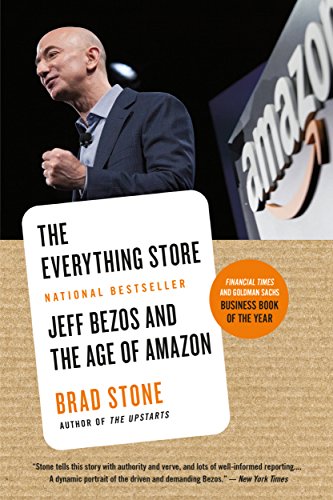Book Review: Everything Store
Published:
Brad Stone’s The Everything Store is a close look at the e-commerce giant Amazon and its founder-CEO, Jeff Bezos. Backed by decades of reporting from its infancy to 2014, Brad documents the company’s journey through rises and falls, as well as the personal growth of its captain. It provides an insider’s perspective on office politics, business strategy, and the workings of one very wealthy thumb.

Here’s the paperback and audiobook.
Utility: ⭐⭐⭐ (3/5)
Writing: ⭐⭐⭐⭐ (4/5)
Brad has a fluid and fast-paced writing style. Each paragraph slides perfectly into the next, creating the illusion of a continuous narrative from a slew of parallel and conflicting plot lines. He also sympathizes with the reader: you don’t have to remember who everyone is (he provides helpful reminders) or sludge through every detail in Amazon’s development (Brad focuses on funny highlights and important turning points). Overall, it was shockingly entertaining for a book that manages to be both a biography and a business case study.
One element that felt a little wanting was the lack of a big picture. Not enough work is done to put each event amidst a broader picture. There’s also a lack of analysis, making it hard to draw concrete lessons from the book. Maybe that’s not the point. But then again, maybe that’s not my cup of tea.
Notes
Business Lessons
Here are the key business lessons I drew from the book:
Prioritize the customer. Bezos insists on leaving a chair empty during meetings. The empty chair, for him, represents the customer. Amazon built a business model based on passing on savings to the customer. Lower prices meant a bigger customer base which enabled more negotiating power. This came at the expense of pissing off rivals and pushing its own employees. But it’s also behind Amazon’s highly refined and constantly improving services. It delivers value.
Long-term thinking. Bezos has a gigantic clock at his Texas ranch that will run for 10,000 years, The clock is supposed to symbolize the importance of being future-oriented. Colleagues say that Bezos has had the same vision for Amazon from the very beginning. To grow into a true everything store, he put the company through countless periods of short-term losses. In the end, those investments paid off.
Embrace conflict. Employees feared Bezos’ legendary “nutters”—outbursts of anger directed at all levels of employees. His characteristic honesty and callousness left many executives disgruntled and frustrated, but he viewed conflict as something to be desired. Conflict enabled a diversity of perspectives and the triumph of the best idea.
Circumscribe chaos. Part of Amazon’s success was its remarkable ability to adjust to fast-paced, uncertain environments. During a period of fast growth, internal coordination faltered and employees insisted on more meetings. Bezos rejected this idea, proposing that true coordination was natural and didn’t require communication. To that end, he replaced presentations with narratives that were to be silently read during meetings.
Just do it. An internal Amazon award given to an employee that bootstraps their own solutions. Bezos strongly preferred in-house innovation, rejecting acquisitions in favor of one-uping competitors. The D-I-Y attitude led to Amazon’s patent for one-click, a breakthrough innovation that created billions in value.
